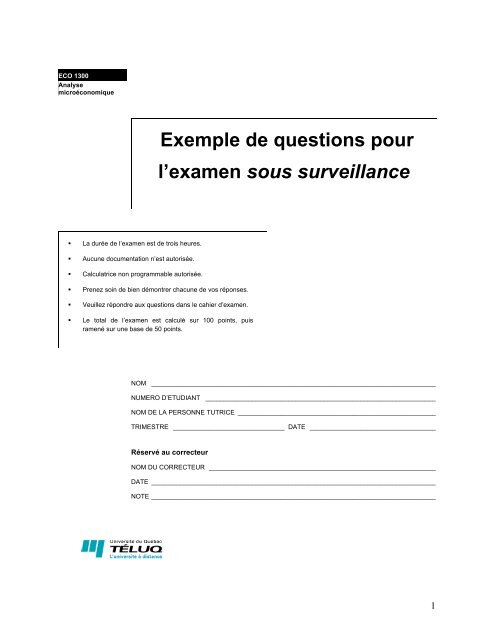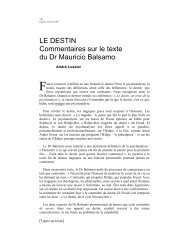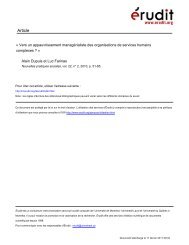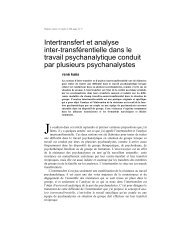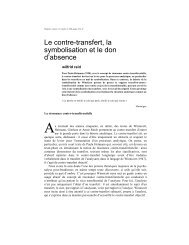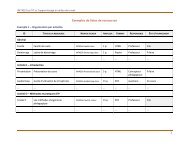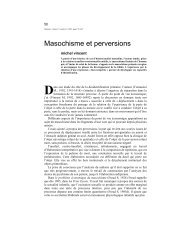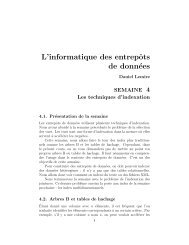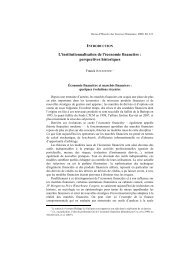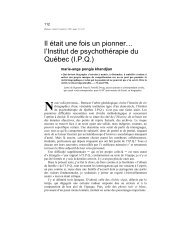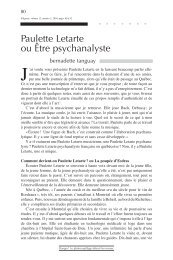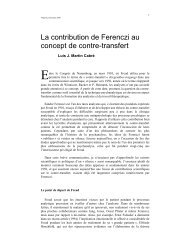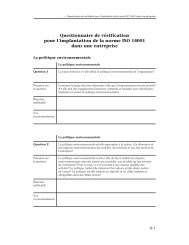Exemple de questions pour l'examen sous surveillance
Exemple de questions pour l'examen sous surveillance
Exemple de questions pour l'examen sous surveillance
You also want an ePaper? Increase the reach of your titles
YUMPU automatically turns print PDFs into web optimized ePapers that Google loves.
ECO 1300<br />
Analyse<br />
microéconomique<br />
<strong>Exemple</strong> <strong>de</strong> <strong>questions</strong> <strong>pour</strong><br />
l’examen <strong>sous</strong> <strong>surveillance</strong><br />
§<br />
§<br />
§<br />
§<br />
§<br />
§<br />
La durée <strong>de</strong> l’examen est <strong>de</strong> trois heures.<br />
Aucune documentation n’est autorisée.<br />
Calculatrice non programmable autorisée.<br />
Prenez soin <strong>de</strong> bien démontrer chacune <strong>de</strong> vos réponses.<br />
Veuillez répondre aux <strong>questions</strong> dans le cahier dʼexamen.<br />
Le total <strong>de</strong> l’examen est calculé sur 100 points, puis<br />
ramené sur une base <strong>de</strong> 50 points.<br />
NOM _______________________________________________________________________________<br />
NUMERO D’ETUDIANT ________________________________________________________________<br />
NOM DE LA PERSONNE TUTRICE _______________________________________________________<br />
TRIMESTRE _______________________________ DATE ___________________________________<br />
Réservé au correcteur<br />
NOM DU CORRECTEUR _______________________________________________________________<br />
DATE _______________________________________________________________________________<br />
NOTE _______________________________________________________________________________<br />
1
Question 1 – Vrai ou faux? La justification est essentielle à<br />
l’obtention <strong>de</strong>s points. – XX points<br />
a) Supposons que l’élasticité croisée entre les biens X et Y est égale à –5. Le prix<br />
du bien Y doit donc augmenter <strong>de</strong> 25 % <strong>de</strong> manière à augmenter la<br />
consommation du bien X <strong>de</strong> 50 %. (5 points)<br />
FAUX<br />
Ec = %ΔQx / %ΔPy<br />
–5 = +50% / %ΔPy<br />
%ΔPy = +50% / -5 => %ΔPy = –10% <strong>pour</strong> obtenir une hausse <strong>de</strong> 50% <strong>de</strong> la<br />
consommation<br />
Accor<strong>de</strong>r 5 points si la réponse est juste et est accompagnée d’une démonstration, zéro<br />
sinon.<br />
b) Si une firme voit ses coûts fixes augmenter <strong>de</strong> 10 %, le prix qui correspond au<br />
seuil <strong>de</strong> fermeture augmente aussi <strong>de</strong> 10 %. (5 points)<br />
FAUX<br />
Seuil <strong>de</strong> fermeture = Min CVM<br />
Pas affecté par le coût fixe.<br />
Accor<strong>de</strong>r 5 points si la réponse est juste et est accompagnée d’une démonstration, zéro<br />
sinon.<br />
2
Question 2 – XX points<br />
La firme Trébon produit une vaste gamme <strong>de</strong> produits laitiers. Elle a estimé la<br />
<strong>de</strong>man<strong>de</strong> et l’offre quotidiennes <strong>pour</strong> un <strong>de</strong> ses produits les plus populaires, soit la<br />
crème glacée.<br />
Q d g = 63 – 4Pg + 3Py + 0.06R<br />
Q o g = 75,6 + 2,6Pg<br />
fonction <strong>de</strong> <strong>de</strong>man<strong>de</strong><br />
fonction d’offre<br />
Où<br />
Qg = nombre <strong>de</strong> litres <strong>de</strong> crème glacée <strong>de</strong>mandé<br />
Pg = prix <strong>de</strong> la crème glacée<br />
Py = Prix du yogourt glacé<br />
R = revenu<br />
a) Si Py = 3$ et R=500$, estimez la fonction <strong>de</strong> <strong>de</strong>man<strong>de</strong> (2 points)<br />
Qdg = 63 – 4Pg + 3(3) + 0.06 (500)<br />
Qdg = 102 – 4Pg<br />
b) Donnez la définition <strong>de</strong> l’élasticité-prix (1 point). Puis, calculer la valeur <strong>de</strong><br />
l’élasticité-prix <strong>de</strong> la <strong>de</strong>man<strong>de</strong> quand le prix <strong>de</strong> la crème glacée passe <strong>de</strong> 5$ à<br />
6$. (2 points)<br />
Ep = ∆Q/∆P * Pm/Qm (1 point)<br />
Si P = 5$ Q= 82<br />
Si P = 6$ Q= 78<br />
Ep = -4/1 * 5,5/80<br />
Ep = 0,27 (2 points)<br />
c) Quel est le prix d’équilibre et quelle est la quantité d’équilibre sur le marché? (3<br />
points)<br />
102 – 4Pg = 75,6 + 2,6Pg<br />
26,4 = 6,6Pg<br />
Pg* = 4$ (2 points)<br />
Q* = 86 (1 points)<br />
3
d) Faites une représentation graphique <strong>de</strong> ce marché (2 points)<br />
prix<br />
25,5$<br />
4$<br />
75,6<br />
86<br />
qté<br />
e) Calculer les surplus du consommateur (2 points), du producteur (2 points) et le<br />
surplus total (1 points). I<strong>de</strong>ntifier les graphiquement (2 points).<br />
SC = (25,5-4)x86/2 = 924,5$ (2 points)<br />
SP = (4x75,6) + (4x10,4)/2 = 323,2$ (2 points)<br />
ST = SC + SP = 1247,7 (1 point)<br />
Graphique : 2 points<br />
prix<br />
25,5$<br />
4$<br />
75,6<br />
86<br />
qté<br />
4
f) Que risque-t-il <strong>de</strong> se produire si le gouvernement décrète un contrôle du prix <strong>de</strong><br />
la crème glacée à 2$. Quantifiez. Combien d’unités seront échangées sur le<br />
marché ? Représentez graphiquement. (7 points)<br />
Qdg = 102 – 4(2) = 94<br />
Qog = 75,6 + 2,6(2) = 80,8<br />
Qdg > Qog => pénurie <strong>de</strong> 13,2 unités<br />
80,8 unités seront échangées sur le marché<br />
prix<br />
25,5$<br />
4$<br />
2$<br />
75,6<br />
80,8 94<br />
86<br />
qté<br />
g) Cette mesure occasionnera-t-elle un gain <strong>de</strong> bien-être ou une perte ? De quelle<br />
ampleur ? (6 points)<br />
Perte : ( (5,3-2) * 5,8)/2 = 9,57<br />
prix<br />
25,5$<br />
5,3$<br />
4$<br />
2$<br />
75,6<br />
80,8 94<br />
86<br />
qté<br />
5


